Slide Rock’s natural water slide is more than a photo op — it shapes how you’ll camp here, from where you pitch to what you pack. You’ll want to know the differences between the developed campground and backcountry spots, what gear keeps you safe around the slick rocks, and how to respect the creek and cliffs. Stick with me and you’ll get practical tips for comfort, permits, and staying safe under the stars.
Choosing Between the Developed Campground and Backcountry Sites
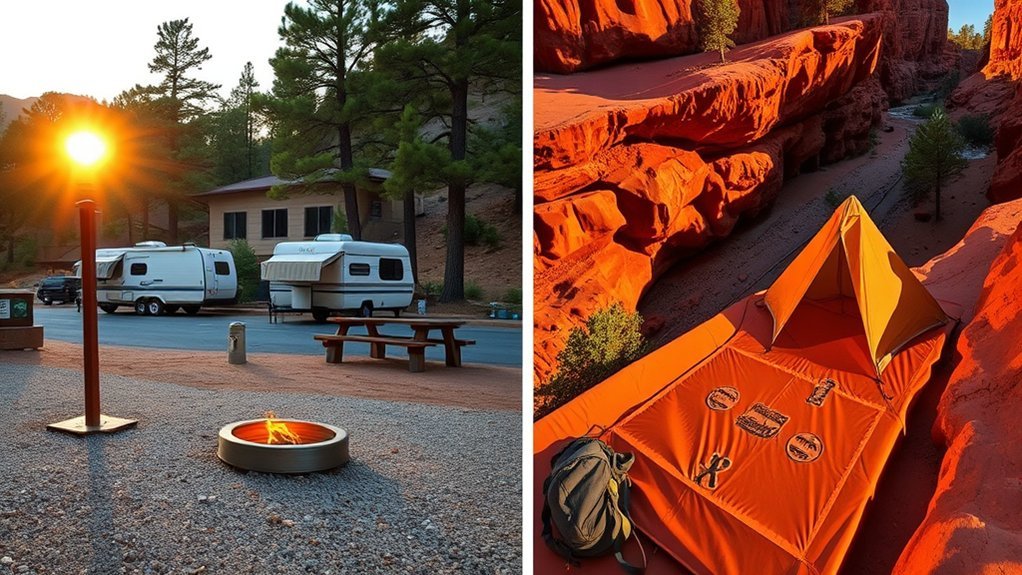
When you’re picking where to sleep at Slide Rock, start by matching your priorities to the site type: the developed campground gives you level pads, potable water, restrooms, and easy vehicle access, while backcountry sites trade comfort for solitude, closer access to trails, and a more primitive experience. If you want predictable facilities, shorter setup, and quick access to the creek for day visits, choose the developed campground — it’s easier with gear and groups. If you prefer quiet, early-morning trailheads, minimal light pollution, and you’re comfortable packing light and following Leave No Trace, pick backcountry sites. Check regulations, distances to water sources, and road access; plan arrival times and emergency options based on the site you select.
What to Pack for Comfort and Safety
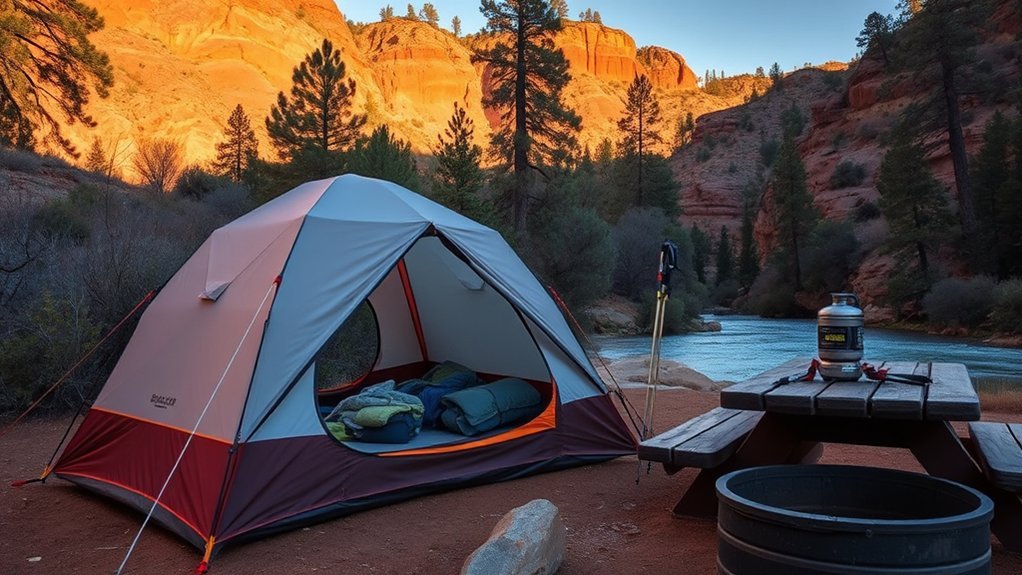
Because comfort and safety depend on both gear and mindset, pack with priority: shelter, water, warmth, navigation, and a basic repair/first-aid kit. You’ll want a sturdy tent or tarp, sleeping system rated for cooler nights, and a lightweight stove for hot meals. Bring enough water or a reliable filter; dehydration is common even near streams. Layer clothing for temperature swings and include rain gear—conditions change fast.
Include a headlamp with extra batteries, map, compass or GPS, and a small multi-tool. Your camping gear list should also contain duct tape, cord, and spare tent stakes for quick fixes. For safety essentials, pack a whistle, blister care, adhesive bandages, antiseptic, and any personal meds. Keep items organized and accessible.
Water, Swimming, and Natural Rock Slides: Safety Tips
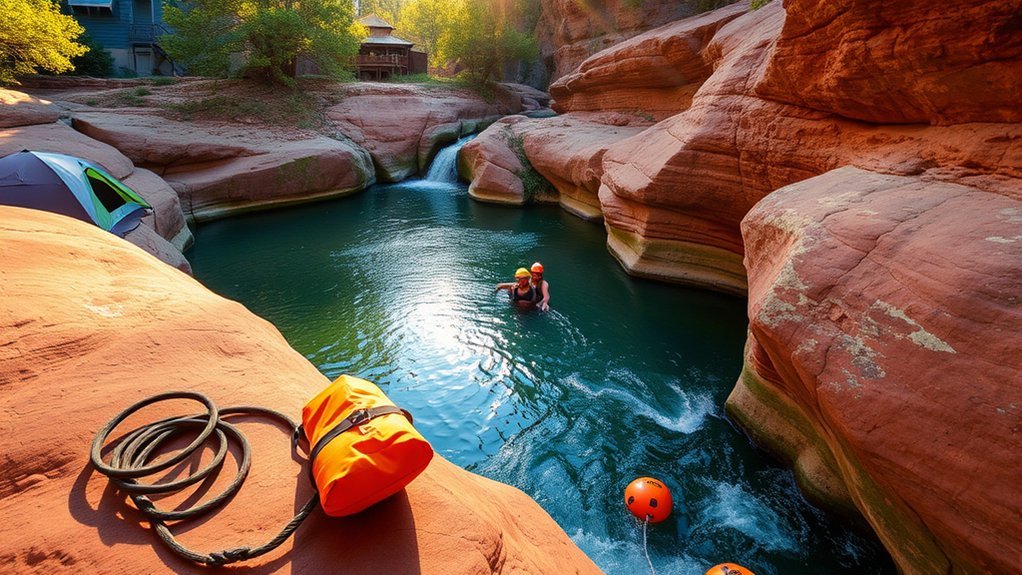
If you plan to swim or slide on the natural rock formations, stay deliberate and cautious: check water depth and current before entering, test slick surfaces with your foot, and avoid jumps or slides where rocks or logs might be hidden below. When you approach the creek, prioritize swimming safety—wear a snug life jacket if currents are strong, keep kids within arm’s reach, and never swim alone. Scan upstream for sudden runoff after storms; currents can surge quickly. For rock slide precautions, move slowly, pick clear exit points, and avoid algae-coated areas that hide traction. Footwear with good grip helps. If conditions look unsafe, postpone fun; it’s better to walk away than risk injury in this rugged, ever-changing environment.
Campsite Setup, Fires, and Leave No Trace Practices
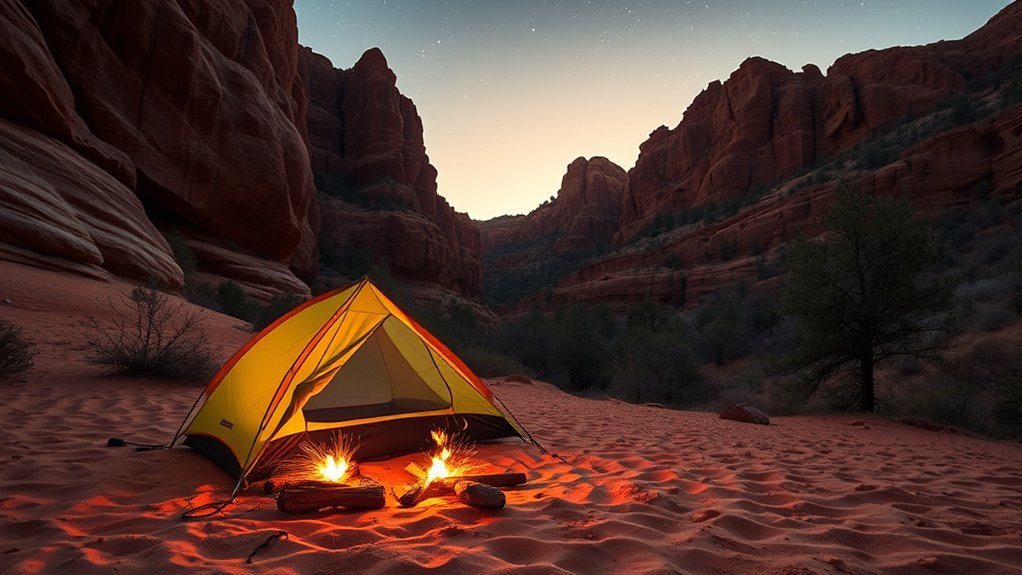
Campsite placement matters: pick a flat, durable spot at least 200 feet from water, trails, and cultural sites so you protect riparian habitat and give other visitors space. Set up tent on groundsheet, arrange gear for quick exits, and practice campsite organization so food and scent items stay secure from wildlife. For fires, use established rings where allowed, keep fires small, and follow fire safety—never leave flames unattended.
- Clear a safe perimeter: remove flammable debris within 5 feet
- Store food in hard-sided containers or locked vehicles
- Pack out all trash and food scraps; bury nothing
- Scatter cooled ashes and dismantle makeshift pits
- Use biodegradable soap at least 200 feet from water
Leave no trace: leave the place as—or better than—you found it.
Navigating Permits, Reservations, and Park Rules
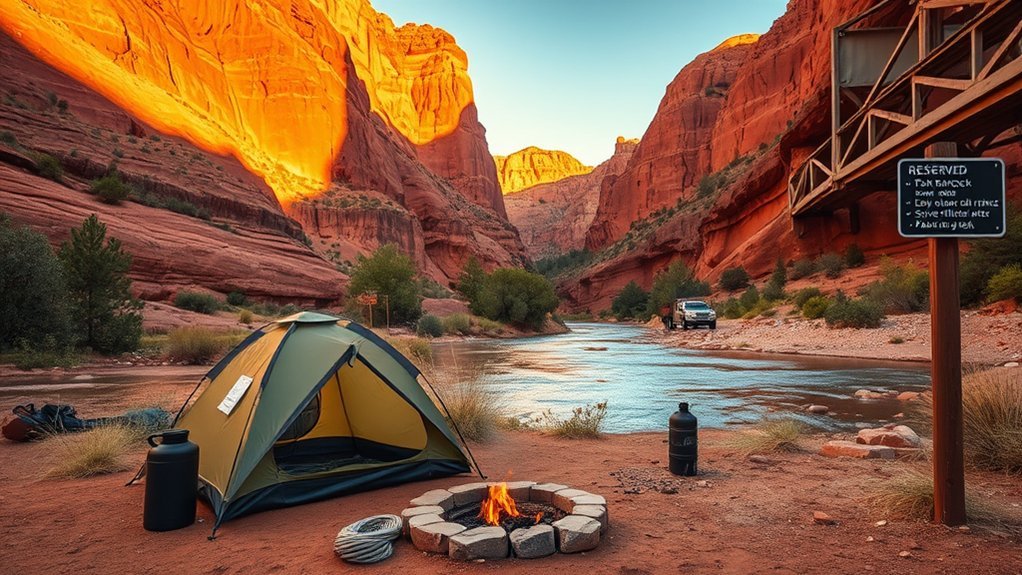
Before you head out, check what permits apply and how much they cost so you won’t be surprised at the gate. You’ll also want to reserve campsites in advance when allowed and learn the specific camping rules—quiet hours, pet policies, and fire restrictions—so you can plan around them. Knowing the permit types, fees, and reservation process makes your trip smoother and helps you follow park regulations.
Permit Types & Costs
When you plan a stay at Slide Rock State Park, you’ll need to understand the park’s permit structure and fees so you can reserve the right pass and avoid surprises at the gate. You’ll complete a permit application online or at the visitor center; the fee structure varies by season, group size, and activity. Know which permit fits your visit—day use, overnight backcountry, or special-use—and budget for extra vehicle or group fees.
- Day-use permit: per person or vehicle fees
- Overnight backcountry: per camper, limited sites
- Group/special-use: additional charges, proof required
- Commercial/guide permits: higher rates, advance approval
- Refund/cancellation terms: check timelines and penalties
Plan ahead, carry receipts, and follow posted limits.
Camping Rules & Reservations
Although you’ll want to book early for peak season, understanding the park’s reservation windows, site types, and rulebook will make your stay smooth and legal. You’ll follow a clear reservation process online or by phone; confirm arrival times, vehicle limits, and whether sites are walk-in, drive-up, or backcountry. Read rules about quiet hours, group size, campfires, and food storage — violators can lose permits. Practice camping etiquette: keep sites clean, pack out trash, respect wildlife, and keep noise low after 10 p.m. If you need a special permit for commercial use or oversized groups, apply well in advance. Bring printed or digital confirmation and ID, note cancellation policies, and check alerts for weather or access changes before you go.
Best Times to Visit, Weather Considerations, and Night Sky Viewing
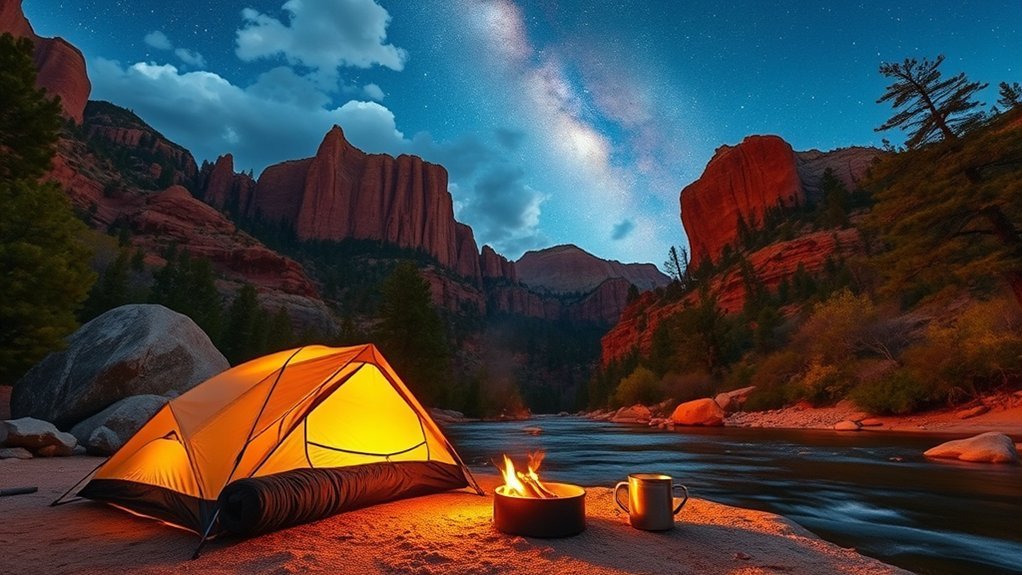
Plan your trip for spring or early fall when temperatures are mild and the crowds thin, but come prepared for afternoon thunderstorms in summer and chilly nights in late season. Check forecasted temps and wind, bring layered clothing and a waterproof layer, and time hikes for morning or late afternoon to avoid the hottest parts of the day. If you want dark skies, pick a moonless night and find a low-lying spot away from parking areas to watch stars and the Milky Way.
Best Months to Go
Wondering which months make Slide Rock State Park shine? You’ll find distinct charms across the year, and picking when to go shapes your experience. Spring brings spring blooms along the creek; fall delivers vivid autumn colors and quieter trails. Consider these windows:
- March–May: early wildflowers, manageable crowds, cooler water.
- June–August: warm swimming, busiest periods, book campsites early.
- September–October: pleasant temps, prime for autumn colors, reduced visitors.
- November–February: cold, limited services, solitude if you’re prepared.
- Full-moon nights in shoulder seasons: great for stargazing and quieter campgrounds.
Aim for late spring or early fall for the best balance of weather, scenery, and fewer people. Pack layers, plan reservations, and match your trip to the vibe you want.
Weather and Night-Sky Tips
Because the weather changes quickly in Oak Creek Canyon, you’ll want to check forecasts and pack layers so you can move from hot, sunlit afternoons to cool, windy evenings without fuss. Visit late spring or early fall for stable weather patterns, fewer crowds, and comfortable nights. Expect afternoon thunderstorms in monsoon season; don’t camp on low ground near the creek and secure tarps and tents against sudden gusts. For stargazing tips, pick a moonless night, set up away from parking lights, and let your eyes adjust 20–30 minutes. Bring a red flashlight, a star chart app, and a reclining camp chair. If you plan a backcountry trip, monitor forecasts closely and have an exit plan for fast-moving storms or temperature drops.
Frequently Asked Questions
Are Campfires Allowed Year-Round in the Developed Campground?
No, campfires aren’t allowed year-round; you’ll need to follow current campfire regulations and seasonal restrictions. You’ll keep campsite safety top priority by checking alerts, using designated rings when permitted, and fully extinguishing fires each time.
Can You Bring Dogs to Backcountry Sites?
No — you can’t bring dogs to backcountry sites; dogs are only allowed on dog friendly trails. You’ll need to plan for pet safety, follow leash rules, provide water, and avoid sensitive wildlife areas.
Are There Potable Water Refill Stations at Trailheads?
No, there aren’t potable water refill stations at trailheads, so you’ll need to treat natural water sources or carry enough for hiking hydration; bring a filter, purification tablets, and extra bottles for practical, worry-free day hikes.
Is Cell Phone Reception Reliable in the Park?
Like a patchy quilt, cell phone reception isn’t reliable throughout the park; you’ll find intermittent cell service near the parking and picnic areas but limited network coverage on trails and in backcountry, so plan accordingly.
Are Group Gatherings or Events Permitted at Campsites?
Yes — you can host small gatherings, but you’ll need to respect posted group size limits and secure event reservations for larger events; check park rules, reserve early, and plan logistics like parking, noise, and Leave No Trace practices.
Conclusion
You’ve got choices: a developed campground for comfort or a backcountry site for solitude. Pack smart—water, layers, first-aid, and Leave No Trace gear—and respect currents and the natural rock slides like it’s 1899 when caution mattered even more. Set up on durable surfaces, follow fire rules, and secure permits or reservations ahead. Visit shoulder seasons for fewer crowds and brilliant night skies, and always put safety and the environment first.

